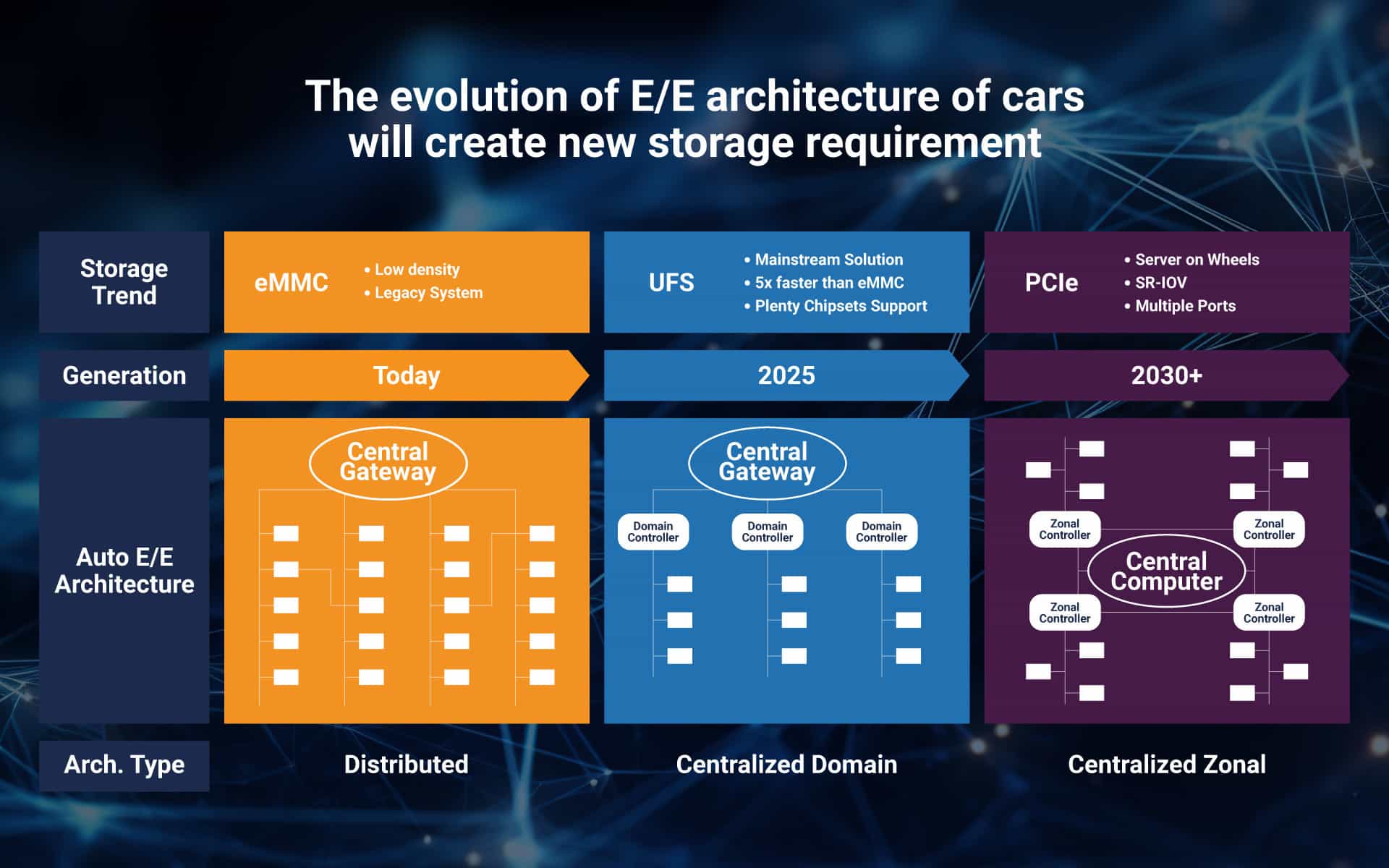This is the third article in a 5-part series about automotive storage. In this piece we take a look at the role of PCIe SSD in a modern vehicle and why PCIe is getting important.
In the previous article, we discussed the role of eMMC and UFS as embedded storage solutions in automotive systems, as well as how UFS is gradually replacing the slower eMMC. However, we all know that PCIe technology is widely used in PC and server systems. It is a high-speed computer expansion bus standard that serves as the common motherboard interface between the processors and other key components, including graphics cards, SSDs, NIC and more. Will PCIe SSDs have a place in the larger automotive systems in the future? The answer is yes! This article will provide a detailed description of the development of PCIe in automotive applications.
The beginning of the PCIe SSD
By the end of 2021, Tesla had gradually replaced its processors based on the Intel Atom A3950 series with AMD Ryzen processors and deployed them in all car models to support its more powerful cockpit systems. This significantly improved video streaming platforms such as YouTube and Netflix, enhanced the smoothness of operation of the browser, created a more responsive and fast touchscreen experience, and enabled users to play Tesla Arcade and Steam games.
This unprecedented cockpit experience not only relies on a powerful processor but also requires a large capacity PCIe SSD with fast read and write performance. With the adoption of a 256 GB PCIe 3.0 SSD, Tesla became the first leading auto maker to extensively use PCIe SSDs as in-vehicle storage solutions. The first reason for the switch to PCIe SSDs was to deliver a better user experience. The second reason was SoCs that supported PCIe as a storage interface. There were other key factors at play as well, such as the evolving automotive electronic architecture.
Figure 1: The modern automotive system has rich applications to enhance user experience
Server on wheels will open up the demand for PCIe SSD
We have discussed the topic of electronic control unit (ECU) consolidation in previous articles. To recap, with increased use of digitization and electrification, the number of ECUs a car requires keeps increasing. Today, the distributed electrical/electronic (E/E) architecture has led to considerations in terms of design cost, supply chain management, space and weight, testing and verification and manufacturing resources. As a result, there is a shift towards a so-called “centralized domain architecture.” Different domain controllers are responsible for tasks with different functionalities, such as advanced driver assistance systems (ADAS), powertrain and infotainment, combining a large number of similar ECUs for computation and data storage. The centralized domain architecture is similar to what we discussed in part 1 of our series.
However, with the fast evolution of new energy and autonomous driving technologies, the automotive E/E architecture still faces various challenges. For example, advanced autonomous driving systems involve 10 to 20 edge sensors. Can you imagine all these sensors located on the periphery of the car being connected to an ADAS domain controller through their individual wire harnesses? Obviously, a large number of wire harnesses may need to span the entire vehicle, increasing the complexity of layout and the number of inputs and outputs (I/O) that need to be supported by the domain controller. Therefore, the concept of “centralized zonal architecture” has gradually become real in recent years.
The difference between centralized zonal architecture and traditional architecture lies in the introduction of the zonal controller and central computer. First, the zonal controller will handle some tasks at the edge, such as:
-
-
- Distributing power to a local region of the vehicle
- Handling communication with local region ECUs
- Preprocessing, aggregating, and sending data to the central computer
-
As for the central computer, it will be responsible for advanced computations and functionalities, especially for the ADAS and infotainment system. The central computer in the system, similar to a server, will have reliable and efficient processing capabilities. At the same time, in addition to high storage bandwidth and larger capacity, it will also need to have some enterprise-class storage features. Without a doubt, this points to the enterprise-class PCIe SSD, which has been used in the server environment for a long time.
Figure 2: The evolution of E/E architecture of cars will create new storage requirement
Enterprise-class PCIe SSD meets fast-evolving automotive market
In enterprise-class SSD storage solutions, there are many differences compared to eMMC/UFS and consumer-grade SSDs. Here are several common indicators and features of enterprise SSDs with a simple explanation of why these are important to the automotive system.
QoS (Quality of Service) and consistency:
This is a measure of whether an SSD’s latency and transfer speed remain at a stable level. Enterprise-grade SSDs prioritize predictable performance over boost performance. In the process of transmitting a large amount of critical data in vehicles, unexpected delays are not allowed.
SR-IOV (Single Root I/O Virtualization):
This feature allows virtual machines to directly access the physical function (PF) and virtual functions (VFs) inside the PCIe SSD without going through a hypervisor, along with their corresponding namespaces in an SSD. This feature ensures the independence of I/O operations and individual security settings. An advanced cockpit system may have two to five different operating systems; for example, there may be multiple Android and Linux operating systems, along with AUTOSAR (Automotive Open System Architecture) and a real-time operating system (RTOS), each individually responsible for functionalities such as entertainment, driver monitoring system (DMS), head-up display (HUD), safety systems or basic ADAS features. By enabling SR-IOV, different data can be isolated and protected, and minimize the workload of the CPU.
Dual-port/multi-port:
In enterprise data center environments, dual-port has become an important feature of PCIe SSDs. This design not only provides data redundancy protection but also allows different hosts to access the data from a single SSD, enabling data sharing. In automotive systems with centralized computing, there is currently no single system on chip (SoC) is powerful enough to handle all the tasks from different domains, so the so-called central computer for now is actually composed of different SoCs. PCIe SSDs with dual-port/multi-port functionality can serve as a shared storage for multiple SoCs to share data, save the cost of a PCIe switch and enhance reliability through redundant lanes design.
In addition to the above three points, other indicators and technologies that differentiate from regular SSD or embedded storage solutions include endurance group, power loss protection (PLP), time to ready (TTR) and more security features. These features heavily rely on the design of the SSD controller and the development of firmware. In fact, the Joint Electron Device Engineering Council (JEDEC) announced the publication of the JESD312 Automotive Solid State Drive (SSD) Device Standard V1.0 in December 2022. This standard defines the specifications for automotive SSDs, indicating the industry’s recognition of the application of PCIe SSDs in the automotive market. As a leading storage technology company, Phison had already been investing in automotive PCIe SSD technology for two years prior to the release of this standard.
Phison is well positioned to meet automotive storage demands
In terms of automotive applications, data transmission and computation demands within automotive systems have been rapidly growing in recent years. In addition to auto makers and Tier 1 suppliers gradually adopting SoCs that support PCIe interface, the future system requirements also align closely with the existing PCIe SSD solutions used in enterprise and data center environments. It can be expected that the importance of PCIe SSDs in automotive systems will gradually increase.
As mentioned earlier, Phison has already begun investing heavily in automotive PCIe Gen4 SSD solutions since 2020. We have also engaged in deep technical collaboration with NAND flash makers, automotive manufacturers, Tier 1 suppliers and SoC suppliers to ensure that our products meet the rapidly evolving automotive market’s demands. In the coming year, we will not only offer conventional automotive PCIe Gen4 SSDs but also provide enterprise-class automotive PCIe Gen4 SSDs with various advanced technologies to meet the needs of state-of-the-art automotive system.













